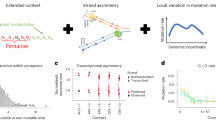Summary
It has been suggested that there may be inequalities in the types of substitution on the two DNA strands (in particular, in the frequencies of transversions from R to Y and from Y to R) due to a higher error rate on the lagging than the leading strand during replication. Reexamination of 11 kb of the β-globin region sequenced in six primates fails to confirm this suggestion. Examination of the 73-kb β-globin region sequenced in humans shows that the frequency of pyrimidines in different parts of this region is more variable than expected in a random sequence, but the pattern is more consistent with nonrandomness generated by DNA turnover mechanisms than with strand asymmetry due to a higher error rate on the lagging strand.
Similar content being viewed by others
References
Bernardi G (1989) The isochore organization of the human genome. Annu Rev Genet 23:637–661
Edenberg HJ, Huberman JA (1975) Eukaryotic chromosome replication. Annu Rev Genet 9:245–284
Fersht AR, Knill-Jones JW (1981) DNA polymerase accuracy and spontaneous mutation rates: frequencies of purine·purine, purine·pyrimidine, and pyrimidine·pyrimidine mismatches during DNA replication. Proc Natl Acad Sci USA 78:4251–4255
Fitch WM (1971) Toward defining the course of evolution: minimum change for a specific tree topology. Syst Zool 20: 406–416
Goodman M, Koop BF, Czelusniak J, Fitch DHA, Slightom JL (1989) Molecular phylogeny of the family of apes and humans. Genome 31:316–335
Hand R (1978) Eucaryotic DNA: organization of the genome for replication. Cell 15:317–325
Lewin B (1990) Genes IV. Oxford University Press, Oxford
Li W-H, Wu C-I, Luo C-C (1984) Nonrandomness of point mutation as reflected in nucleotide substitutions in pseudogenes and its evolutionary implications. J Mol Evol 21: 58–71
Maeda N, Bliska JB, Smithies O (1983) Recombination and balanced chromosome polymorphism suggested by DNA sequences 5′ to the human δ-globin gene. Proc Natl Acad Sci USA 80:5012–5016
Maeda N, Wu C-I, Bliska J, Reneke J (1988) Molecular evolution on intergenic DNA in higherprimates: pattern of DNA changes, molecular clock, and evolution of repetitive sequences. Mol Biol Evol 5:1–20
Miyata T, Hayashida H, Kuma K, Mitsuyasu K, Yasunaga T (1987) Male-driven molecular evolution: a model and nucleotide sequence analysis. Cold, Spring Harbor Symp Quant Biol 52:863–867
Tautz D, Trick M, Dover GA (1986) Cryptic similarity in DNA is a major source of genetic variation. Nature 322:652–656
Topal MD, Fresco JR (1976) Complementary base pairing and the origin of substitution mutations. Nature 263:285–293
Wu C-I, Maeda N (1987) Inequality in mutation rates of the two strands of DNA. Nature 327:169–170
Author information
Authors and Affiliations
Rights and permissions
About this article
Cite this article
Bulmer, M. Strand symmetry of mutation rates in theβ-globin region. J Mol Evol 33, 305–310 (1991). https://doi.org/10.1007/BF02102861
Received:
Revised:
Issue Date:
DOI: https://doi.org/10.1007/BF02102861




